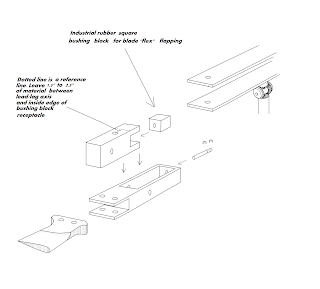I wanted to share a few words regarding my interest in HMI (Human Machine Interface). My goal is practical application, so if you're a dooms day follower...sorry I let you down. The human interface software that interests me is none invasive and the idea is to aid operation rather "turn it loose" on it's own and see what happens. Regarding my helicopter designs, for example, should a pilot pass out, the system would notice the unwanted changes in flight control input. I always want a "human in the loop". The only "invasive human interface I think would be ok is that regarding amputees or paralyzed people. They're doing wonderful work to that end and even National Geographic did an article on it.
This effort is not an attempt to replace any UAS. It is simply an update on my approach/effort to civil UAS and manned platforms. I am still not funded by the Army regarding my patent (Pat # 8,226,026 B2) nor is my endeavor to get the platform off of paper and into the air. But, I'm still going to keep "plugging" away on my own. The designs that I've given to the Army/DOD are separate. Further I have nothing to do with any military rotorcraft/aerospace programs outside of the designs that were given.
I finally made head way in getting the 2nd coaxial HIR prototype into the air with fairly good control for the first hop flight. No swash plate.
Some of you may be thinking it resembles the Japanese GEN H4 or the Airscooter coaxial systems, but those respective airframes, though innovative, are simply tilt mast and both airframes are fixed pitch. Now, my small scale coaxial is also fixed pitch, but it's not simply "tilt mast". It is two airframes that are interconnected with the upper airframe containing the rotor system, tilting independently from the lower airframe, thereby allowing for the application of full collective pitch and yet the weight remains equally distributed between both airframes. If the upper airframe tilts forward, the rotor thrust is vectored as well as the lower portion of the upper airframe that interconnects with the lower airframe via a longitudinal lever/airframe strut, moves aft, but at equal moments, "flexing" the CG rather than a lateral or linear shift in weight within the airframe. A sort of "pendulum" flex, if you will. My theory.
If you review the video clips of the GEN H4 flying, the operator appears to have a "cautious" hold on the control stick that tilts the power plants and masts, but it appears too "loose" as if it may be more easily to over correct, but I cannot be certain. It appears not to be intuitive. With "planform" morphing/HIR airframes, the control stick manipulates both airframes, but not in a "stick to the rotor discs" manner. Connecting the weight of both airframes together, to include the pilot weight in a manned platform, adjusts the the attitude of the upper airframe/masts for direction control. Should any atmospheric gusts hit the rotor discs, it will be translated into both airframes, pilot weight, and then to the control stick. That translation from the rotor discs is "buffered". Further, there may be better control feedback to the operator. With the GEN H4, an atmospheric gust would seem to translate straight to the control stick as the rotor masts/power plants ride on a single gimbal. My platform will use a gimbal as well, but there are always two attachment points between the two airframes with the control stick controlling movement between the two. The GEN H4 has one attachment point between the rotor discs and lower airframe. Two if you count the pilot's hand on the control stick. Now, I need to get the 1st single mast prototype flying. The airscooter again is fixed pitch. Further, it utilizes both a dif. gear system and a polychain pulley system.
Later this week, I will move outdoors and attempt maneuvering around obstacles. Last year, my original plan was to include some sort of "SMART" software that will assist in keeping the airframe in the most optimal configuration for translational flight. If you can remember learning to ride a bicycle and Mom or Dad kept their hand on the seat as you peddled away until you internalized the balance required and then they would let go of the seat. SMART software that can sense pilot control inputs and then make a decision of whether or not to adjust stick control input or take over. But, as of right now, my airframe is only a physical human interface regarding the weight of the pilot moving, interacting and assisting the airframe configuration in control of the platform/thrust vectoring during flight. Time will tell.














